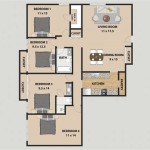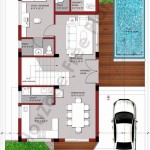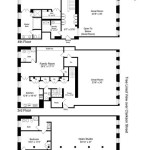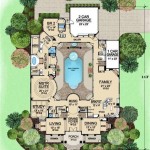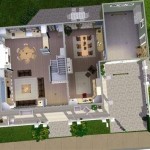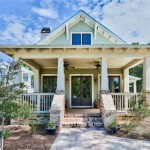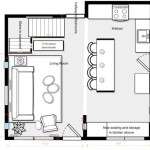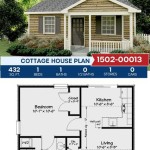```html
Traditional Country Home Plans: A Guide to Classic Design
Traditional country home plans evoke a sense of nostalgia, comfort, and enduring charm. These designs prioritize functionality, warmth, and a connection to the surrounding landscape. They often incorporate elements that hark back to simpler times, emphasizing craftsmanship and natural materials. Understanding the key features and variations within this broad style allows prospective homeowners to select a plan that best suits their needs and preferences. This article explores the characteristics of traditional country home plans, delving into common architectural elements, interior design considerations, and adaptations for modern living.
Key Architectural Elements in Traditional Country Homes
Traditional country home plans are characterized by several distinct architectural features that contribute to their overall aesthetic and functionality. These elements often draw inspiration from historical precedents, adapted to suit contemporary living.
One defining characteristic is the emphasis on natural materials. Wood, stone, and brick are frequently employed in exterior and interior construction. Wood siding, often clapboard or board-and-batten, is a prevalent exterior cladding option, providing a rustic and timeless appearance. Stone foundations and chimneys add character and durability. Brick accents, such as walkways and patios, further enhance the natural aesthetic.
Roofing styles are another important consideration. Gable roofs, with their simple, triangular shape, are a common feature, often complemented by dormers that provide additional light and space in upper levels. Hip roofs, with their sloping sides that meet at a ridge, are also frequently used, offering a more substantial and weather-resistant design. The roof pitch, or angle of the roof, is typically moderate to steep, allowing for efficient water runoff and snow shedding.
Porches and verandas are integral to traditional country home plans. These outdoor spaces provide a transition between the interior and exterior, offering a place for relaxation and socializing. Front porches, often spanning the entire width of the house, are particularly common, creating a welcoming and inviting entrance. Verandas, which wrap around the sides of the house, offer extended outdoor living space and protection from the elements. Porch columns, often made of wood and adorned with decorative details, further enhance the visual appeal.
Windows play a crucial role in the overall design. Double-hung windows, with their vertically sliding sashes, are a classic choice, providing ventilation and natural light. Multi-pane windows, with their divided glass panes, add character and contribute to the traditional aesthetic. Bay windows, which project outward from the wall, are often incorporated to provide additional light and space. Window shutters, typically made of wood, add a decorative touch and offer protection from the elements.
Chimneys are frequently incorporated into traditional country home plans, serving as both a functional element for fireplaces and a visual focal point. Brick chimneys are particularly common, adding a sense of solidity and permanence to the design. The chimney's location on the exterior of the house can also contribute to the overall symmetry and balance of the facade.
Interior Design Considerations for Country Homes
The interior design of a traditional country home should complement the architectural style, creating a cohesive and harmonious living space. The emphasis is typically on warmth, comfort, and functionality, with a focus on natural materials and handcrafted details.
Wood flooring is a common choice, providing a durable and visually appealing surface. Hardwood floors, such as oak, maple, or pine, are particularly popular, offering a timeless and classic look. Wide-plank flooring adds a rustic and characterful touch. Area rugs, often made of natural fibers such as wool or cotton, can be used to define different zones and add warmth and texture.
Fireplaces are often central to the interior design, serving as both a source of heat and a focal point. Stone or brick fireplaces are particularly common, adding a sense of solidity and permanence to the living space. Wood-burning stoves can also be incorporated, providing a more efficient heating option. Mantels, often made of wood and adorned with decorative details, provide a place for displaying artwork and other personal items.
Kitchens in traditional country homes are typically designed to be both functional and inviting. Farmhouse sinks, with their deep basins and exposed fronts, are a popular choice, adding a touch of rustic charm. Cabinetry is often made of wood, with Shaker-style cabinets being a particularly common option. Open shelving can be used to display dishes and cookware, adding a sense of informality and accessibility. Islands provide additional counter space and storage, making the kitchen more efficient and user-friendly.
Color palettes in traditional country homes often emphasize warm and earthy tones. Cream, beige, and light gray are common choices for walls, providing a neutral backdrop for furniture and accessories. Accents of color, such as blues, greens, and reds, can be used to add visual interest and personality. Wallpaper, with patterns that evoke nature or historical designs, can also be used to add character and texture to the walls.
Furniture in traditional country homes is typically comfortable and functional, with a focus on quality craftsmanship. Upholstered furniture, such as sofas and armchairs, provides a comfortable place to relax and socialize. Wood furniture, such as tables and chairs, adds warmth and character to the space. Antiques and vintage pieces can be incorporated to add a sense of history and authenticity.
Adapting Traditional Country Home Plans for Modern Living
While traditional country home plans evoke a sense of nostalgia, they can be adapted to meet the needs of modern living. This involves incorporating contemporary amenities and technologies while preserving the classic aesthetics of the style.
Open floor plans are a common adaptation, creating a more spacious and flexible living space. Combining the kitchen, dining area, and living room into one open space allows for better flow and interaction between family members and guests. This adaptation can be achieved without sacrificing the overall character of the traditional country home.
Energy efficiency is an important consideration in modern home design. Incorporating energy-efficient windows and doors, insulation, and HVAC systems can significantly reduce energy consumption and lower utility bills. Solar panels can also be installed to generate renewable energy. These energy-efficient features can be seamlessly integrated into the traditional country home design without compromising the aesthetic appeal.
Modern kitchens and bathrooms are often incorporated into traditional country homes. Modern appliances, such as stainless steel refrigerators and dishwashers, can be integrated into the kitchen design. Modern bathroom fixtures, such as walk-in showers and soaking tubs, can be incorporated into the bathroom design. These modern amenities can be combined with traditional elements, such as farmhouse sinks and clawfoot tubs, to create a balanced and functional space.
Smart home technology can also be integrated into traditional country homes. Smart thermostats, lighting controls, and security systems can enhance comfort, convenience, and security. These technologies can be discreetly integrated into the home design without detracting from the traditional aesthetic.
Outdoor living spaces can be expanded to include features such as outdoor kitchens, fireplaces, and patios. These outdoor spaces can provide additional areas for relaxation, entertaining, and enjoying the natural surroundings. Pergolas, decks, and landscaping can enhance the beauty and functionality of the outdoor living spaces, seamlessly blending them with the traditional country home design.
In conclusion, traditional country home plans offer a timeless and charming aesthetic that can be adapted to meet the needs of modern living. By understanding the key architectural elements, interior design considerations, and adaptation strategies, prospective homeowners can create a comfortable and functional home that reflects their personal style and preferences.
```
Traditional Country Farmhouse Design At Family Home Plans House Floor Style

Floor Plan Friday Big Traditional Country House

Floor Plan Friday Big Traditional Country House Dream Plans
Traditional Country Farmhouse House Plans Home Design Dd 6501 11367

House Plan 56906 Traditional Style With 1842 Sq Ft 3 Bed 2 Ba

Traditional Country Ranch Farmhouse House Plan Home Style Plans Small Floor

Traditional Country Farmhouse House Plans Home Design E167 16999

Plan 51953 Traditional Country House With Colonial Style C

Beautiful Small Country House Plans With Porches Houseplans Blog Com

Traditional Victorian Farmhouse House Plan Design 173 1007

